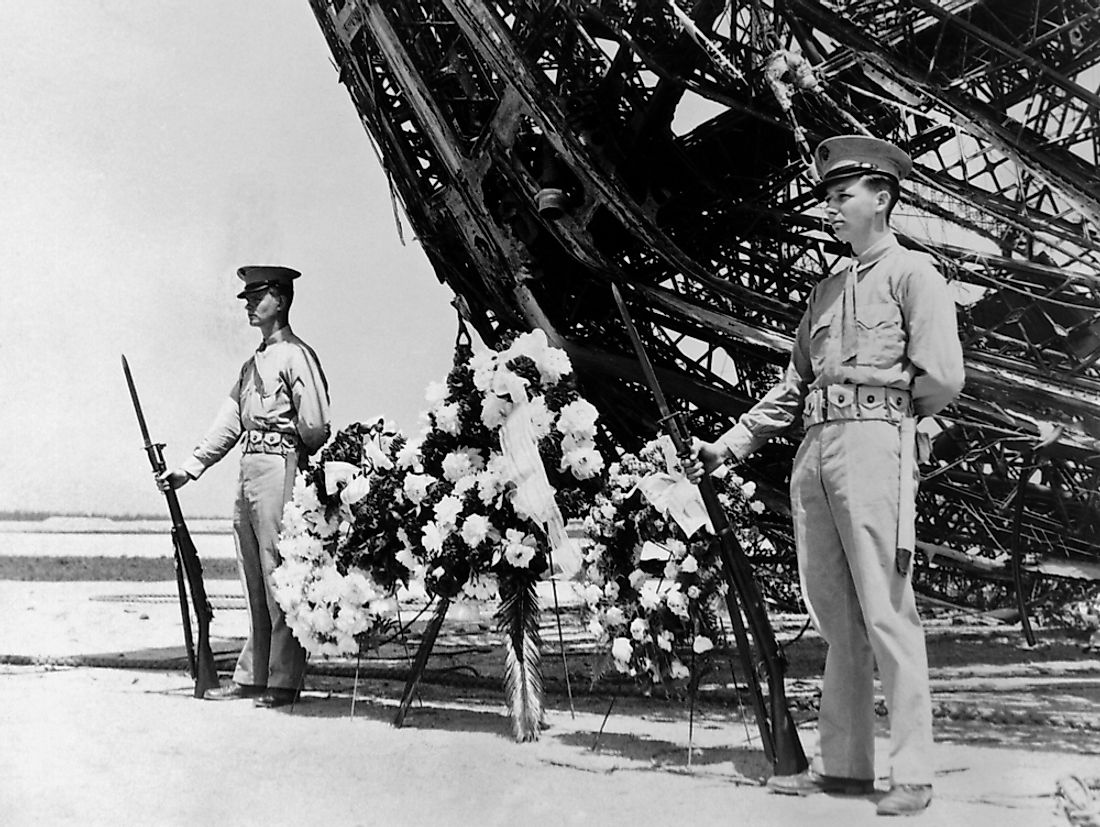The Hindenburg Disaster

Eighty years ago, on May 6, 1937, airship LZ 129 Hindenburg, the world’s largest dirigible burst into flames after coming into contact with its mooring mast in Lakehurst, New Jersey killing 35 passengers and crew of the total 97 that were on board, as well as one ground crew member. Most of those who survived the accident suffered severe burn injuries. The airship had left Frankfurt three days earlier on May 3, 1937 for Lakehurst’s Navy Air Base across the Atlantic Ocean. This disaster ended airship projects as people lost confidence in them.
The Disaster
The Hindenburg was behind schedule and the poor weather and thunderstorms further delayed its docking. After the storm cleared, unreliable wind direction complicated the docking procedure and, at around 7:25 pm, several witnesses saw gas leakage near the upper fin flutter while others reported seeing a bluish flame at the back of the ship. Shortly afterward the fire erupted and the Hindenburg was beyond salvation. There is no clear agreement as to where the fire erupted from as different eyewitness accounts seem to differ. Some eyewitnesses said the fire broke out on the top fit close to cells 4 and 5 of the ventilation shafts. Other sources claimed the fire first broke out in front of the horizontal port fin followed by other flames on the front upper fin. Another reliable account claimed that the fire began behind the rudders near cell 1. The exact location of the fire notwithstanding, it spread quickly and consumed cell 1 to 9 before the rear end of the airship imploded followed by the bursting of two tanks that made the ship lose its buoyancy and it came crashing down, tail first as more flame came out the nose. All these, from the first flame to the crash happened in less than forty seconds. More flame points emerged and burnt most of the airship’s fabric for several hours.
Death Toll
Of the total 36 passengers and 61 crewmen on board, 13 passengers, 22 aircrewmen, and one ground crewman died. Most of the victims burnt to death while others died on impact after jumping from the airship. Smoke and falling debris also caused some deaths.
Cause of the Fire
There were several theories advanced to explain the cause of the fire that razed the Hindenburg, these are, sabotage, lightning, static spark, and engine failure theories.
Sabotage: Hugo Eckener of the Zeppelin Company initiated this theory claiming that they had received threatening letters before the flight. Commander Charles Rosendahl who was in charge of Lakehurst Naval Air Station, Max Pruss, who previously commanded the Hindenburg, and authors Michael MacDonald Mooney and A. A. Hoehling, as well as a few crew members, believed this theory. However, later on, Eckener deviated from this point of view and came up the static spark theory.
Static spark: Eckener believed that there was a build-up of static electricity that caused an electric spark to ignite hydrogen on the airship’s outer skin. According to this theory, as the airship traveled, it passed through high electric charge and humidity. As it came to dock and as the airship dropped the mooring lines, they became wet and set off an electric discharge responsible for the spark.
Lightning: NASA’s A.J. Dessler believed that during Hindenburg’s years, it had been struck by lightning severally. Though lightning does not cause fires on airships, on this disaster, it struck as Hindenburg was venting massive hydrogen that mixed with atmospheric oxygen. However, no witness ever reported seeing lighting.
Engine failure: This theory gained momentum 70 years after the accident and had its foundation on the interview records of ground crew members. Apparently, several ground crew members noted that, after one of the turns, one of the engines failed and emitted sparks that ignited the skin.











